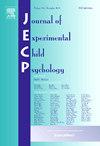Development of an innovative approach to the assessment of eye–hand coordination in a dual-task context in prepubertal children
IF 1.8
2区 心理学
Q3 PSYCHOLOGY, DEVELOPMENTAL
引用次数: 0
Abstract
The purposes of this study were to examine both the validity and reliability of an eye–hand coordination (EHC) test in a dual-task paradigm in prepubertal children and the capacity of this test to discriminate between sex and age. A total of 440 children aged 6 and 11 years participated in this study. To assess EHC, a ball throwing and wall catching test was used in three different conditions (non-interference, auditory, and visual). In each condition, the duration of the test was 90 s. The numbers of successful throws and mistakes in each condition were recorded. The study demonstrated robust validation, with high interclass correlation coefficients (ICCs) indicating excellent reliability. The ICC for the number of EHC successes was.980 (95% confidence interval (CI) = [.969,.987], p < .001), whereas the ICC for EHC mistakes was.856 (95% CI = [.782,.905], p < .001). The standard error of measurement (SEM) was 3.17 (5.36%) for EHC successes and 1.396 (19.86%) for EHC mistakes. In addition, significant differences were observed between boys and girls (p < .05). In conclusion, the EHC test demonstrated good reliability and validity among prepubertal children. These findings validate the tool’s robustness for use in research and practice. Moreover, boys showed superior performance, which decreased in the dual-task condition regardless of age, sex, or type of interference.
求助全文
约1分钟内获得全文
求助全文
来源期刊

Journal of Experimental Child Psychology
Multiple-
CiteScore
4.50
自引率
7.70%
发文量
190
期刊介绍:
The Journal of Experimental Child Psychology is an excellent source of information concerning all aspects of the development of children. It includes empirical psychological research on cognitive, social/emotional, and physical development. In addition, the journal periodically publishes Special Topic issues.
 求助内容:
求助内容: 应助结果提醒方式:
应助结果提醒方式:


